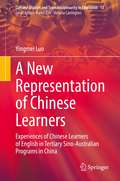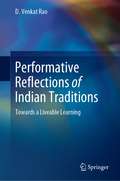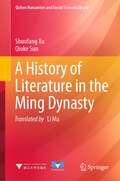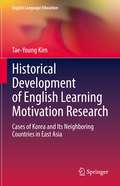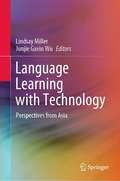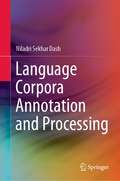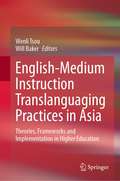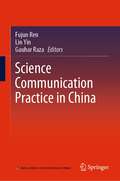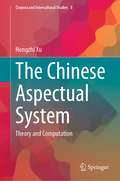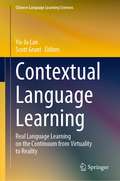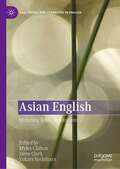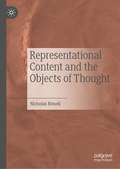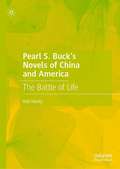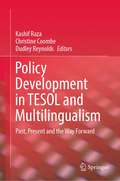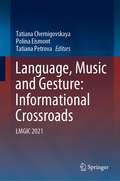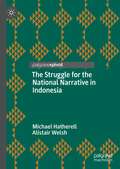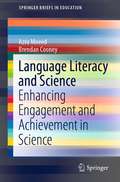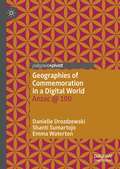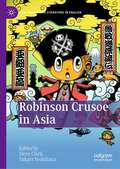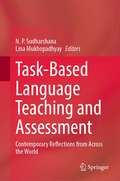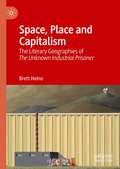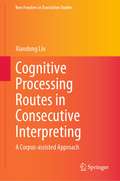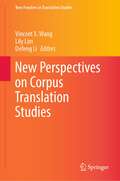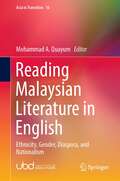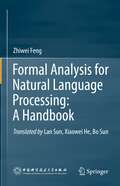- Table View
- List View
A New Representation of Chinese Learners: Experiences of Chinese Learners of English in Tertiary Sino-Australian Programs in China (Cultural Studies and Transdisciplinarity in Education #13)
by Yingmei LuoThis book examines Chinese tertiary students' experiences of learning English in Sino-Australian programs in China. Using an institutional ethnography, the book examines one well-established Sino-Australian program based at a Chinese university. The book explores the ways that participant students used the Chinese words, tropes and their meanings to describe their English learning experiences with both local Chinese and foreign English teachers. This book introduces an innovative theoretical framework, “representation theory with a multilingual perspective”, to analyse how Chinese students' everyday experiences are constructed and mediated through language, discourse and identity. This framework also highlights graphic examples of how concepts are created in both Chinese and English, and thus serves as a powerful tool for deconstructing dichotomies between China and the West. The aim of this book is, then, two-fold: to show how a novel theoretical lens can help us to develop more nuanced understandings of Chinese students, and to propose a new methodological and theoretical framework through which one can challenge the monolingual subjectivity and parochial views of both Chinese and Western conceptions.
Performative Reflections of Indian Traditions: Towards a Liveable Learning
by D. Venkat RaoThis book focuses on the cohering elements across various texts and traditions of India. It engages with several significant works from the Sanskrit tradition and emphasizes the need to move beyond colonial and postcolonial engagements with the enduring cultural pasts of India. The chapters are grouped in three main parts: accented rhythms, dispersed mnemoscapes and inventive iterations. It addresses questions such as: what enabled cultural communication across very divergent geographical, temporal, locational contexts and among different cultural formations of India over millennia? What is this shareable impulse that pulsates across the domains of dance, sculpture, painting, poetry, dharma, music, medicine, the lore of rivers and the epics? It explains how modern Indian languages and especially their creative and reflective nodes are unthinkable without the intricately woven textures of these interfaces and their responsive receptions. This book is of interest to philosophers, humanities students, researchers and professors as well as people interested in exploring alternatives to European traditions of thought without an alibi.
A History of Literature in the Ming Dynasty (Qizhen Humanities and Social Sciences Library)
by Shuofang Xu Qiuke SunThis book explores poems, novels, legends, operas and other genres of writing from the Ming Dynasty. It is composed of two parts: the literary history; and comprehensive reference materials based on the compilation of several chronologies. By studying individual literary works, the book analyzes the basic laws of the development of literature during the Ming Dynasty, and explores the influences of people, time, and place on literature from a sociological perspective. In turn, it conducts a contrastive analysis of Chinese and Western literature, based on similar works from the same literary genre and their creative methods. The book also investigates the relationship between literary theory and literary creation practices, including those used at various poetry schools. In closing, it studies the unique aesthetic traits of related works. Sharing valuable insights and perspectives, the book can serve as a role model for future literary history studies. It offers a unique resource for literary researchers, reference guide for students and educators, and lively read for members of the general public.
Historical Development of English Learning Motivation Research: Cases of Korea and Its Neighboring Countries in East Asia (English Language Education #21)
by Tae-Young KimThis book clarifies the fundamental difference between North America-based instrumental motivation and Korea (and East Asia)-specific competitive motivation by which the EFL learners’ excessive competition to be admitted to famous universities and to be hired at a large-scale conglomerate is the main source of L2 motivation. It enables readers to understand that EFL-learning motivation reflects unique sociohistorical contexts grounded in a specific region or country. This book in turn necessitates the need to develop EFL motivation theory and research tradition which are firmly based on East Asian values and culture.
Language Learning with Technology: Perspectives from Asia
by Lindsay Miller Junjie Gavin WuThis book is about language learning with technology, offering readers theoretical insights as well as practical case studies with a focus on Asia and Asian students. Although technology is rapidly advancing and most, if not all, students are already using technology in their everyday lives, traditional teaching/learning practices still exist throughout Asia. This book provides examples, written by representative educators, from a variety of countries/regions and contexts where technology has successfully been used to enhance language learning. In addition to some everyday examples of using technology: Wikipedia, PowerPoint, Google Docs and YouTube, the book also offers the readers an insight into the future possible uses of advanced technology: Augmented Reality, Virtual Reality, Artificial Intelligence and Eye Tracking. The book presents illustrations of how teachers can, and perhaps should, be open to integrating some form of technology into in-class learning or using it to supplement out-of-class activities.
Language Corpora Annotation and Processing
by Niladri Sekhar DashThis book addresses the research, analysis, and description of the methods and processes that are used in the annotation and processing of language corpora in advanced, semi-advanced, and non-advanced languages. It provides the background information and empirical data needed to understand the nature and depth of problems related to corpus annotation and text processing and shows readers how the linguistic elements found in texts are analyzed and applied to develop language technology systems and devices. As such, it offers valuable insights for researchers, educators, and students of linguistics and language technology.
English-Medium Instruction Translanguaging Practices in Asia: Theories, Frameworks and Implementation in Higher Education
by Wenli Tsou Will BakerThis book examines translanguaging pedagogy in Asia’s English-medium instruction (EMI) higher education. It presents an overview of concepts and common issues, and case studies from specific contexts in Asia. The book first interrogates macro-level English-medium instruction policies and implementation from English as a lingua franca (ELF) perspectives. Following this, implications of English as a lingua franca on English-medium instruction pedagogy will be explored, with a theoretical framework of 'translanguaging pedagogy' developed. The book concludes with a discussion on translanguaging and how the concept contributes to English-medium instruction in Asia. Through the book, the content focuses on the specificity of each Asian English-medium instruction context from a translanguaging lens. English-medium instruction policies and translingual practices from China, Japan, Taiwan, Thailand, and Vietnam are explored, and opportunities and challenges related to translanguaging pedagogy in Asian English-medium instruction classrooms are examined.
Science Communication Practice in China
by Fujun Ren Lin Yin Gauhar RazaChina has made remarkable and rapid progress in the area of science communication, both in theory and practice. This book critically examines all aspects of science communication practices in China. Dealing with major turning points since the introduction of the ‘Science and Technology Popularization Law’ and the ‘Outline of the National Scheme for Scientific Literacy’, the book tells a success story by scrutinizing structural changes in science communication policies, education system, construction and efficacious utilisation of science popularisation facilities, and creative use of a mix of traditional and modern channels of communication. The book also gives an in-depth analysis of the monitoring and evaluation mechanism, which constitutes the backbone of the national science communication project. The historical roots of science communication in China include shifts in methodologies, policy instruments, effectual approaches and resultant practices since the days of initial efforts to popularise modern scientific ideas. However, the primary focus of the book remains on the initiatives launched at the turn of the present century. Without losing sight of the national dimensions, each chapter of the book draws from provincial as well as grassroots level experiences. Quantitative and qualitative methods have been used to analyse strengths, weaknesses, hurdles and the efficacy of corrective measures. This book offers a remarkable insight to anyone who is interested in probing the causal relationship between science communication and China’s transformation into a modern society. The primary objective of the book is to analyse the nature of ‘science communication with Chinese characteristics’ and the specificity of the socio-cultural environment in which Science and Technology is located. Though the book is of particular interest to scholars, researchers, students and practitioners of science communication, the narrative style makes it accessible to the general reader who is interested in science-society relationship.
The Chinese Aspectual System: Theory and Computation (Corpora and Intercultural Studies #8)
by Hongzhi XuThis book presents a theoretical study on aspect in Chinese, including both situation and viewpoint aspects. Unlike previous studies, which have largely classified linguistic units into different situation types, this study defines a set of ontological event types that are conceptually universal and on the basis of which different languages employ various linguistic devices to describe such events. To do so, it focuses on a particular component of events, namely the viewpoint aspect. It includes and discusses a wealth of examples to show how such ontological events are realized in Chinese. In addition, the study discusses how Chinese modal verbs and adverbs affect the distribution of viewpoint aspects associated with certain situation types.In turn, the book demonstrates how the proposed linguistic theory can be used in a computational context. Simply identifying events in terms of the verbs and their arguments is insufficient for real situations such as understanding the factivity and the logical/temporal relations between events. The proposed framework offers the possibility of analyzing events in Chinese text, yielding deep semantic information.
Contextual Language Learning: Real Language Learning on the Continuum from Virtuality to Reality (Chinese Language Learning Sciences)
by Yu-Ju Lan Scott GrantThis book presents research and developments in the virtual, augmented technology and mixed-reality used in language learning and teaching. It provides the readers with a comprehensive overview of contextual language learning with the support of immersive technology. From theoretical foundations, methodological issues, the features of virtual and augmented reality, and educational practices of language learning, to the future of immersive technology for and research on language learning. During the past two decades, abundant research on different realities has recognized the potential of language learning in virtual, augmented, and mixed-reality environments (Wang et al., 2020; Lin & Lan, 2015). Given insufficient studies of Chinese learning in immersive contexts reported in existing literature, this book includes several excellent studies about using immersive technologies for Chinese learning in addition to other foreign langue learning, such as English as a foreign language (EFL). Since learning Chinese has grown significantly as a global trend, the authors vitally consolidate and synthesize various theoretical foundations, visions, and recent research and practices in the context of Chinese teaching from broader and more diverse perspectives. On the other hand, the chapters about EFL learning also shed light on the research on contextual language learning. Thus, the chapters included in this book will likely provide readers with a deep and extensive understanding of the potential of the smart combination of immersive technologies and language learning. More issues for future research will undoubtedly be inspired by reading the chapters in this book.
Asian English: Histories, Texts, Institutions (Asia-Pacific and Literature in English)
by Steve Clark Myles Chilton Yukari YoshiharaContesting the idea that the study of Anglophone literature and literary studies is simply a foreign import in Asia, this collection addresses the genealogies of textual critique and institutionalized forms of teaching of English language and literature in Asia through the 19th and 20th centuries, along with an examination of how its present options and possible future directions relate to these historical contexts. It argues that the establishment of Anglophone literature in Asia did not simply “happen”: there were extra-literary and -academic forces at work, inserting and domesticating in Asian universities both the English language and Anglo-American literature, and their attendant cultural and political values. Offering new perspectives for ongoing conversations surrounding the globalization of Anglophone literature in literary and cultural studies, the book also considers the practicalities of teaching both the language and its canon of classic texts, and that the historical formation and shape of English studies in Asia offers lessons that relate not only to the discipline but also may be applied to the humanities as a whole.
Representational Content and the Objects of Thought
by Nicholas RimellThis book defends a novel view of mental representation—of how, as thinkers, we represent the world as being. The book serves as a response to two problems in the philosophy of mind. One is the problem of first-personal, or egocentric, belief: how can we have truly first personal beliefs—beliefs in which we think about ourselves as ourselves—given that beliefs are supposed to be attitudes towards propositions and that propositions are supposed to have their truth values independent of a perspective? The other problem is how we can think about nonexistents (e.g., Santa Claus) given the widespread view that thought essentially involves a relation between a thinker and whatever is being thought about. The standard responses to this puzzle are either to deny that thought is essentially relational or to insist that it is possible to stand in relations to nonexistents. This book offers an error theory to the problem. The responses from this book arise from the same commitment: a commitment to treating talk of propositions—as the things towards which our beliefs are attitudes—as talk of entities that actually exist and that play a constitutive and explanatory role in the activity of thought.
Pearl S. Buck’s Novels of China and America: The Battle of Life
by Rob HardyThis book, the first single-authored book-length study of Buck’s fiction for over twenty years, shows how Buck’s thought developed through the medium of her fiction - from her early turbulent years in China to her last lonely days in the United States, with chapters examining her loss of faith in Christianity, her reflections on Chinese life during and after the breakdown of Old China, her voluminous reading, her confrontation with the horrors of American racism and sexism after her return to the United States, and her final metaphorical search for home as she approached death. The book argues that Buck, the first American woman to win both the Pulitzer and Nobel prizes for literature, was a heroic forerunner of those who, while occupying a place in the world, never feel fully at home there; in Buck’s case because her Chinese identity throughout her life struggled with her American. For this reason Pearl S. Buck’s fiction deserves to be considered alongside that of writers such as Anchee Min, Maxine Hong Kingston and Amy Tan. The book’s central claim is that Buck is a major novelist, capable of speaking to the distress of our times, richly deserving the honor she has received in China, and deserving greater recognition in the United States.
Policy Development in TESOL and Multilingualism: Past, Present and the Way Forward
by Christine Coombe Kashif Raza Dudley ReynoldsThe book is of interest to scholars of multilingualism, language teachers, researchers, and administrators who are developing policies on teaching English and promoting multilingualism. Given its scope, this edited collection provides an overview of how multilingualism is transforming the practice of Teaching English to Speakers of Other Languages (TESOL) in diverse contexts around the world. It serves as a platform for discussions related to policy enactment where TESOL and multilingualism are viewed as collaborative endeavours and approaches the topic from three different angles. The first section of the book provides critical examinations of previous initiatives and accomplishments in the area of language policy development and implementation. The second section describes current projects and initiatives intended to expand and strengthen the field of TESOL while providing space for local and indigenous languages to develop. The third and last part of the book highlights policy development areas that need special consideration in order to develop a form of TESOL that builds on and contributes to multilingualism.
Language, Music and Gesture: LMGIC 2021
by Tatiana Chernigovskaya Polina Eismont Tatiana PetrovaThis book brings together selected revised papers representing a multidisciplinary approach to language, music, and gesture, as well as their interaction. Among the number of multidisciplinary and comparative studies of the structure and organization of language and music, the presented book broadens the scope with the inclusion of gesture problems in the analyzed spectrum. A unique feature of the presented collection is that the papers, compiled in one volume, allow readers to see similarities and differences in gesture as an element of non-verbal communication and gesture as the main element of dance. In addition to enhancing the analysis, the data on the perception and comprehension of speech, music, and dance in regard to both their functioning in a natural situation and their reflection in various forms of performing arts makes this collection extremely useful for those who are interested in human cognitive abilities and performing skills. The book begins with a philosophical overview of recent neurophysiological studies reflecting the complexity of higher cognitive functions, which references the idea of the baroque style in art being neither linear nor stable. The following papers are allocated into 5 sections. The papers of the section “Language-Music-Gesture As Semiotic Systems” discuss the issues of symbolic and semiotic aspects of language, music, and gesture, including from the perspective of their notation. This is followed by the issues of "Language-Music-Gesture Onstage" and interaction within the idea of the "World as a Text." The papers of “Teaching Language and Music” present new teaching methods that take into account the interaction of all the cognitive systems examined. The papers of the last two sections focus on issues related primarily to language: The section "Verbalization Of Music And Gesture" considers the problem of describing musical text and non-verbal behavior with language, and papers in the final section "Emotions In Linguistics And Ai-Communication Systems” analyze the ways of expressing emotions in speech and the problems of organizing emotional communication with computer agents.
The Struggle for the National Narrative in Indonesia
by Michael Hatherell Alistair WelshThis book offers a unique analysis of how political representatives construct ideas about the nation in contemporary Indonesian politics. In their struggle to define what the authors call the ‘national narrative’, would-be national leaders seek to develop a story about the nation’s past, present and future. These stories feature a unique plot, set of characters, and a moral that the political narrator hopes will resonate. In contemporary Indonesia, the authors assess two prominent national narratives: the technocratic and populist national narratives. The book concludes with an analysis that considers other potential sources of ideas about the nation, as well as the potential implications for domestic politics and Indonesian grand strategy.
Language Literacy and Science: Enhancing Engagement and Achievement in Science (SpringerBriefs in Education)
by Azra Moeed Brendan CooneyThis book presents the findings of two case studies in the 'Making Connections' two-year project funded by the New Zealand Ministry of Education. It shows how science literacy was improved in a state coeducational school with Pacific Island students from diverse linguistic backgrounds. This book details ideas and strategies relevant to schools where English literacy has an impact on the science engagement and achievement of ethnically diverse student populations. It also presents the teaching as inquiry model and its usage by teachers to improve aspects of their teaching strategies.
Geographies of Commemoration in a Digital World: Anzac @ 100
by Danielle Drozdzewski Shanti Sumartojo Emma WatertonThis book reframes commemoration through distinctly geographical lenses, locating it within experiential and digital worlds. It interrogates the role of power in representations of memory and shows how experiences of commemoration sit within, alongside and in contrast to its official normative forms. The book charts how memories, places and experiences of commemoration play out and have, or have not, changed in and through a digital world. Key to the book’s exploration is a new epistemology of memory, underpinned by an embodied research approach.
Robinson Crusoe in Asia (Asia-Pacific and Literature in English)
by Steve Clark Yukari YoshiharaThis collection of essays expands the study of that immensely widely read and much-adapted novel, beyond the first book – The Life and Strange Surprising Adventures of Robinson Crusoe (usually known simply as Robinson Crusoe) – to take in the far less well-known Farther Adventures and the almost unread Serious Reflections, beyond Defoe’s texts, to their re-writing and adaptation and beyond the Atlantic and South American context to an Asian and Pacific context. The essays consider both how Asia is represented in the books (in terms of politics, economics, religion), and how the book has been received, adapted, and taught, particularly in Asian contexts.
Task-Based Language Teaching and Assessment: Contemporary Reflections from Across the World
by N. P. Sudharshana Lina MukhopadhyayThis book provides interdisciplinary perspectives on task-based language teaching (TBLT) and task-based language assessment (TBLA) in English as a second language (ESL) context. It discusses theoretical and experimental insights of TBLT and TBLA from cognitive, cognitive linguistic, and psycholinguistic viewpoints. The chapters, written by leading language teaching specialists in the field, introduce the reader to a comprehensive range of issues related to TBLT and TBLA such as curriculum design, materials development, and classroom teaching & testing. With interdisciplinary appeal, the book is a valuable resource for researchers in task-based language teaching and assessment. It is equally useful for teachers to whom it offers practical suggestions for designing tasks for teaching and testing.
Space, Place and Capitalism: The Literary Geographies of The Unknown Industrial Prisoner
by Brett HeinoThis book is an original contribution to literary geography and commentaries on the work of David Ireland. It plots the relationship between the spaces and places of 1970s Australian capitalism as it evolves through Ireland’s 1971 Miles Franklin prize-winning novel The Unknown Industrial Prisoner. In particular, the book theorises the relationship between space and place in literature through two highly innovative arguments: a focus on the spatial unconscious as a means to assess and track the spatiality of capitalism in the novel form; and the articulation of a regime of space through the perceived, conceived and lived constitution of space. Drawing together concepts from radical geography and structural Marxist literary theory, it explores the dominance of the regime of abstract space in the Australian context. The text also examines the nature and possibilities of place-based strategies of resistance, and concludes by suggesting opportunities for future research and plotting the ways in which The Unknown Industrial Prisoner continues to speak to contemporary Australia.
Cognitive Processing Routes in Consecutive Interpreting: A Corpus-assisted Approach (New Frontiers in Translation Studies)
by Xiaodong LiuThis book addresses a controversial issue regarding SL-TL transfer in the translation process, namely the question as to the dominant route in English-Chinese and Chinese-English professional consecutive interpretations, respectively: the form-based processing route or meaning-based processing route. It presents a corpus-assisted product study, in which the interpreting processing patterns of culture-specific items (CSIs) are analyzed. The study reveals that the dominant route in English vs. Chinese consecutive interpreting varies under different circumstances. Four factors are proposed to account for such differences: linguistic variables (e.g., grammatical complexity of the unit), type of CSI, language direction, and extra-linguistic variables (e.g., multilateral or bilateral settings). In summary, the book systematically introduces a corpus-assisted approach to translation process research, which will benefit all readers who are interested in translation process research but cannot employ neuroscientific measures.
New Perspectives on Corpus Translation Studies (New Frontiers in Translation Studies)
by Defeng Li Lily Lim Vincent X. WangThe book features recent attempts to construct corpora for specific purposes – e.g. multifactorial Dutch (parallel), Geasy Easy Language Corpus (intralingual), HK LegCo interpreting corpus – and showcases sophisticated and innovative corpus analysis methods. It proposes new approaches to address classical themes – i.e. translation pedagogy, translation norms and equivalence, principles of translation – and brings interdisciplinary perspectives – e.g. contrastive linguistics, cognition and metaphor studies – to cast new light. It is a timely reference for the researchers as well as postgraduate students who are interested in the applications of corpus technology to solving translation and interpreting problems.
Reading Malaysian Literature in English: Ethnicity, Gender, Diaspora, and Nationalism (Asia in Transition #16)
by Mohammad A. QuayumThis book brings together fourteen articles by prominent critics of Malaysian Anglophone literature from five different countries: Australia, Italy, Malaysia, Singapore, and the US. It investigates the thematic and stylistic trends in the literary products of selected writers of the tradition in the genres of drama, fiction, and poetry, from its beginnings to the present, focusing mainly on the postcolonial themes of ethnicity, gender, diaspora, and nationalism, which are central to the creativity and imagination of these writers. The book explores the works of not just the established writers of the tradition but also those who have received little critical attention to date but who are equally gifted, such as Adibah Amin, Edward Dorall, Rehaman Rashid, and Huzir Suleiman. The chapters collectively address the challenges and achievements of writers in the English language in a country where English is widely used in daily life and yet marginalised in the creative domain to elevate the status of writings in the national language, i.e., Bahasa Malaysia. The book will demonstrate that in spite of such recurrent neglect of the medium, Malaysia has produced a number of outstanding writers in the language, who are comparable in creativity and craftsmanship to writers of other Anglophone traditions. The book will be of interest to readers and researchers of Malaysian literature, postcolonial literatures, minority literatures, gender studies, and Southeast Asian studies.
Formal Analysis for Natural Language Processing: A Handbook
by Zhiwei FengThe field of natural language processing (NLP) is one of the most important and useful application areas of artificial intelligence. NLP is now rapidly evolving, as new methods and toolsets converge with an ever-expanding wealth of available data. This state-of-the-art handbook addresses all aspects of formal analysis for natural language processing. Following a review of the field’s history, it systematically introduces readers to the rule-based model, statistical model, neural network model, and pre-training model in natural language processing. At a time characterized by the steady and vigorous growth of natural language processing, this handbook provides a highly accessible introduction and much-needed reference guide to both the theory and method of NLP. It can be used for individual study, as the textbook for courses on natural language processing or computational linguistics, or as a supplement to courses on artificial intelligence, and offers a valuable asset for researchers, practitioners, lecturers, graduate and undergraduate students alike.
